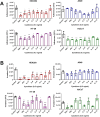Cytokine-mediated inhibition of Staphylococcus aureus adherence and invasion into nonphagocytic cells
- PMID: 40540014
- PMCID: PMC12181134
- DOI: 10.1007/s00430-025-00840-4
Cytokine-mediated inhibition of Staphylococcus aureus adherence and invasion into nonphagocytic cells
Abstract
Staphylococcus aureus is a major pathogen responsible for a wide range of infections, from minor skin diseases to life-threatening conditions, such as sepsis and pneumonia. Its ability to invade nonphagocytic cells, evading the immune system and persisting intracellularly complicates the treatment and contributes to recurrent infections. In this study, we investigated the role of cytokines in inhibiting S. aureus adherence and invasion into nonphagocytic human cells. Monomac-6 cells were stimulated with heat-killed S. aureus (HKSA) to produce a cytokine cocktail, which was used to treat various human cell lines, including HEK293, A549, HaCaT, and HT29. Our results demonstrate that cytokines significantly reduced S. aureus adherence and invasion into HEK293, HaCaT, and HT29 cells by altering the expression of key host cell receptors for S. aureus adhesins and invasion, such as integrins and heat shock proteins. These effects of cytokines were mediated via JAK-STAT pathway as tofacitinib supplementation, a JAK inhibitor, reversed the effects of cytokine cocktail. However, these effects were not observed in A549 cells, most likely due to their ability to actively internalize pathogens. These findings suggest that cytokines provide a crucial line of defense against the ability of S. aureus to invade nonphagocytic cells by modulating the expression of host cells receptors.
Supplementary Information: The online version contains supplementary material available at 10.1007/s00430-025-00840-4.
Keywords: Bacterial adherence; Bacterial invasion; Cytokines; Receptors for adhesin and invasin; Staphylococcus aureus.
Conflict of interest statement
Declarations. Competing interests: The authors declare no competing interests.
Figures





Similar articles
-
The integrin-binding domain of invasin is sufficient to allow bacterial entry into mammalian cells.Infect Immun. 1992 Sep;60(9):3909-12. doi: 10.1128/iai.60.9.3909-3912.1992. Infect Immun. 1992. PMID: 1500198 Free PMC article.
-
Treatment for chronic methicillin-sensitive Staphylococcus aureus pulmonary infection in people with cystic fibrosis.Cochrane Database Syst Rev. 2018 Jul 27;7(7):CD011581. doi: 10.1002/14651858.CD011581.pub3. Cochrane Database Syst Rev. 2018. PMID: 30052271 Free PMC article.
-
Systematic review of the effectiveness of preventing and treating Staphylococcus aureus carriage in reducing peritoneal catheter-related infections.Health Technol Assess. 2007 Jul;11(23):iii-iv, ix-x, 1-66. doi: 10.3310/hta11230. Health Technol Assess. 2007. PMID: 17580002
-
Nasal Staphylococcus aureus and S. pseudintermedius carriage in healthy dogs and cats: a systematic review of their antibiotic resistance, virulence and genetic lineages of zoonotic relevance.J Appl Microbiol. 2022 Dec;133(6):3368-3390. doi: 10.1111/jam.15803. Epub 2022 Sep 27. J Appl Microbiol. 2022. PMID: 36063061 Free PMC article.
-
Diversity and antibiotic susceptibility profiles of bacterial isolates from wound infections in patients at the surgical unit of Kisii teaching and referral hospital, Kenya.PLoS One. 2025 Jun 17;20(6):e0326048. doi: 10.1371/journal.pone.0326048. eCollection 2025. PLoS One. 2025. PMID: 40526640 Free PMC article.
References
-
- Gonzalez BE, Martinez-Aguilar G, Hulten KG, Hammerman WA, Coss-Bu J, Avalos-Mishaan A, Mason EO Jr., Kaplan SL (2005) Severe Staphylococcal sepsis in adolescents in the era of community-acquired methicillin-resistant Staphylococcus aureus. Pediatrics 115:642–648. 10.1542/peds.2004-2300 - PubMed
-
- Nasser A, Azimi T, Ostadmohammadi S, Ostadmohammadi S (2020) A comprehensive review of bacterial osteomyelitis with emphasis on Staphylococcus aureus. Microb Pathog 148:104431. 10.1016/j.micpath.2020.104431 - PubMed
-
- Jensen AG, Espersen F, Skinhoj P, Rosdahl VT, Frimodt-Moller N (1997) Increasing frequency of vertebral osteomyelitis following Staphylococcus aureus bacteraemia in Denmark 1980–1990. J Infect 34:113–118. 10.1016/s0163-4453(97)92395-1 - PubMed
LinkOut - more resources
Full Text Sources

